Wednesday 29 December 2010
Patagonian Mara - A Little Bit of Everything
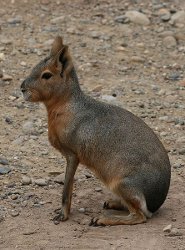
The
Patagonian Mara (
Dolichotis patagonum) lives in south and central Argentina mainly in areas of scrub desert or coarse grassland. It is a
rodent resembling a short eared hare also called the Patagonian hare or Patagonian cavy but is actually a close relative of the guinea pig. It is one of the few rodents that mate for life, and its social structure is based on this. Pairs will travel everywhere together with the female in the lead and the male watching out for danger.
They usually keep to themselves except during breeding time. At that time they will share a burrow with other families with litters. The burrows are dug by the females. The pups are born well developed with open eyes. The female will identify her young by smell and lead them a little distance from the burrow to suckle. The male watches over the family at this time for predators. This unique social organization is thought to give more protection to the young. They live up to 10 to 15 years.
The third largest rodent in the world, the Patagonian Mara is 69 - 75 cm (about 2 feet) long. It can run very fast for its size, up to 45 kilometers (28 miles) per hour for distances over 1 kilometer, because it has powerful hind legs. The front legs are adapted for digging their burrows with four sharp claws. When fully grown they stand about 2 feet (.61 meters) at the shoulder, are 2.5 feet (.76 of a meter) long and weigh 35 pounds (15.88 kilograms).
The Patagonian Mara is gradually heading for the endangered species list. Its habitat is being cleared for agriculture and it is in competition for the green vegetation it eats with sheep and the European hare that have been introduced to the region. It is hunted by birds of prey, snakes and some mammals. Some localized populations have already become extinct. It is living in at least 12 protected areas at the present time. It is classified NT (near threatened) on the IUCN Red List.
This mammal seems to be a strange combination of several animals. They are fast runners like rabbits, and they can hop 6 feet into the air when startled. They walk like deer, and have some of the same coloring of deer or antelope with white on their underside and tail. They fold their front paws like a cat when resting in the sun. Their face resembles a kangaroo.
Picture of the Patagonian mara by Luis Argerich, licensed under the
Creative Commons Attribution 2.0 Generic license.
You can help spreading the word about this animal by liking it on facebook
Permanent Link
Thursday 23 December 2010
Brush-tailed Phascogale - A Bottle Brush for a Tail
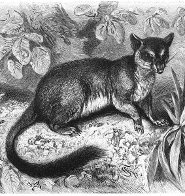
The
Brush-tailed Phascogale (
Phascogale tapoatafa) is a mammal about the size of a large rat found only in certain areas of Australia: New South Wales, Queensland and the Northern Territory. Also known as the Common Wambenger (!) or the Tuan, the Brush-tailed Phascogale is best known for the tuft of silky black hairs at the end of its long tail.
Description
The body, legs, and head of the Brush-tailed Phascogale are covered by a deep grizzled-grey fur, with a pale creamy undercoat. The rat-like head is crowned with large bare pointed ears. The tail, usually as long as the body, ends in a tuft of black hair much like a kitchen bottle brush. The average male is 15.8" (401 mm) long, and weighs 7 ounces (199 grams); the average female is 13.9" (352 mm) long and weighs 4.7 ounces (145 grams).
Habitat
The Brush-tailed Phascogale prefers areas with an annual rainfall over 20" (500 mm), in such regions as open forests, swamps, and rain forests. This marsupial is a very agile climber of trees, and often hangs head down from branches. The Brush-tailed Phascogale nests in tree hollows lined with shredded bark and leaves, often moving to many different hollows over their short lifetimes.
Position in Food Chain
An nocturnal hunter, the Brush-tailed Phascogale eats insects, spiders, beetles, cockroaches, and centipedes, and occasionally a small lizard or bird. They are the prey of the
red fox and all types of cats.
Reproduction
Males, after being weaned, travel long distances to establish their own territories; females usually stay where they are born. When the time comes to mate, around June or July, the male travels long distances to find a female. A male dies almost immediately after mating season is over, around the age of one year.
Females, however, live longer, up to three years, but produce only one litter in their lifetime. Nesting in the hollow of a tree, an expectant female will, within thirty days, bear a litter of seven or eight young, who will spend their first seven weeks in their mother's marsupial pouch. Once the young leave the pouch, they will stay in the nest for five more months, until they are weaned.
Species Vulnerability
Originally, the Brush-tailed Phascogale was well-established throughout Australia. But, because of the destruction of their natural habitat, and continual predation, these marsupials have disappeared from most of Australia. The species is officially listed as having a "Near Threatened" status.
You can help spreading the word about this animal by liking it on facebook
Permanent Link
Monday 20 December 2010
Giant Noctule - Preying on nocturnal birds
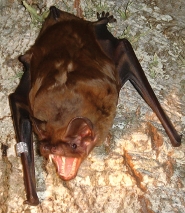
The
Giant Noctule (
Nyctalus lasiopterus) is a rare, flying mammal also known as the Greater Noctule Bat. They are found scattered around the Iberian Peninsula in southwest Europe, the Balkans in southeastern Europe, and the Ural region in western Russia. They have also been spotted in Morocco and Libya in northern Africa, as well as in Turkey, northern Iran, and Kazakhstan.
These bats weigh approximately 1.7 ounces (50 grams), and possess a wingspan of up to 23 inches (60 cm). Despite their small stature, they are surprisingly predatory, and small passerine
birds who migrate at night are in danger. Within the past decade, it has been found that Giant Noctules chase, catch, and eat fowl prey while in flight.
They use echolocation to navigate, forage, and hunt in the dark. They echolocate within specific frequency ranges that are above the hearing range of birds, which gives the bats the upper hand during the hunt. They fly higher up in the air, upwards of .3 miles (500 meters) to find prey, and researchers believe that spring and autumn, peak months for bird migration, are prime hunting seasons for these predatory bats.
During peak migration periods, the diet of Giant Noctules consists largely of passerine, or small perching birds. These birds are caught and eaten on the wing, in mid-air during flight, rather than from nests or perches. This species is the only known bat species that feeds like this, see also
this article. Insects are also an important source of food. They have a few natural predators in the wild including owls, which can capture bats during flight, just as Giant Noctules capture passerine birds.
They are native to certain countries in Europe, North Africa, and West Asia including Spain, France, Bulgaria, Romania, and the Ukraine. Their natural habitat consists of mixed and deciduous forests, as well as wooded river valleys. The Giant Noctules are highly dependent on mature woodlands containing old trees. They use hollow trees to roost in summertime, and rock crevices during the winter months, which are a time of hibernation. Old buildings are also common roosting sites.
Giant Noctules are considered to be a near threatened animal. Their population appears to be decreasing due largely to deforestation. In particular, the loss of old trees, which are crucial to supporting bat colonies, and the disturbance of other roosting sites, such as old buildings, threaten these small, remarkable creatures' survival.
Picture of the giant noctule by Nicol Harper, licensed under
Creative Commons Attribution 2.5 Generic license.
You can help spreading the word about this animal by liking it on facebook
Permanent Link
Friday 17 December 2010
Gummy Shark- The Polka Dot Shark

The
Gummy shark (
Mustelus antarcticus) is found in the south of Australia. It is a slender shark, grey and with white spots along its body. They can also be bronze or greenish with a white belly, and the characteristic spots. This shark measures approximately 157 cm long, for males, and 175 cm for females; in this species the female seems to be larger. This species is not endangered and is cataloged as of "least concern" in the endangered species chart. In the shark family, it belongs to the Trikidae. This type of shark reproduces by oviviparity - when species embryos are in eggs, but they are kept inside the mother until they are ready to hatch. They give birth in the months of October -December. Mothers can give birth to as many as 40 babies, known as "pups;" however, they can also carry one. The average of pups is about 14. Mother sharks are pregnant for twelve months. The Gummy shark eats mostly crustaceans, small
fish, squid, octopus, and marine worms.
One characteristic of the Gummy shark is that the second dorsal fin is as big or almost as big as the first fin. The fins are also rounded at the top. It also has whiskers near each nostril. These two characteristics differentiate it from school sharks since they tend to look alike, and sometimes, fishermen might get the species mixed up due to their close resemblance - this is one reason why the restriction for fishing is two fish for both species combined, whether a school fish or a gummy shark. Another way is by looking at their teeth; the gummy shark has flat teeth while the other species has small sharp teeth.
This shark has become popular as cuisine; its meat is known as flake. Australian cuisine benefits from the boneless filets, which are also great served as fish and chips - a popular and delicious plate. The meat is sweet and delicious and it can be done barbecued, baked, poached, or braised. This fish has not been endangered or over-fished due to the restrictions that have been established - only two are allowed and with a minimum size of 45 cm. However, this limit of two applies to Gummy sharks and /or school sharks, whether they are fished whole or as partial carcasses - since gummy sharks and school sharks can be found together in the same waters. This has kept the population from being endangered.
The Gummy shark can be found deep in the sea as far as 400 meters and their life span can be as long as 16 years. It seems that the biggest predator of this shark is human. Before the fishing laws and restrictions in effect, this shark was being over fished due to its meat being so marketable and tasty.
You can help spreading the word about this animal by liking it on facebook
Permanent Link
Thursday 16 December 2010
Afghan Pika - Living High Off The Land
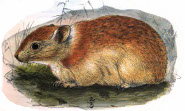
The
Afghan pika (
Ochotona rufescens), a terrestrial animal, is known for its adaptability to high altitudes. Native to the mountains of the Middle East, this mammal can be found specifically in Pakistan, Iran and its namesake, Afghanistan. The mammal is also indigenous to Armenia and Turkmenistan. Its habitat is rocky desert but is also found in temperate forests and burrowed in dry fields without stones.
These
lagomorphs are small and oval-shaped, with males and females similar in size and weight. Its body is generally grey and brown, with tinges of cream coloring during summer months and heavy brown fur in winter. Eyes are widely set to offer a broad field of vision. The average weight is less than 500 grams (17.6 ounces) while average length ranges from 120 to 300 millimeters (4.7 to 11.8 inches.) Ears are round and large for its body, growing as long as 1.4 inches (36 millimeters). In contrast, both its head and legs are short and its tail barely visible. Because of poor heat dissipation and high body temperatures, the pika easily adapts to cold environments.
Unlike rodents, which have one pair of upper incisors, the Afghan pika has an additional set of upper teeth, but this extra pair is not sharp. Its diet consists of plants native to a dry habitat, including thistles. Pikas will also consume fresh feces to re-digest nutrients. The species has been known to damage orchards and agricultural crops in search of vegetation. Plants are stacked and dried in piles for future use. Although they tend to steal bedding and food from each other, pikas work in small groups to watch for predators, including birds of prey and other mammals. Warnings are emitted through sharp whistles.
Breeding season runs from mid-March to late September with a short gestation period. Newborn pikas are born blind and helpless and either hairless or slightly furred. Weaned after 22 days, pikas become adults within seven weeks of birth. Females can therefore become pregnant fairly young. The average litter ranges from five to seven, with as many as five litters per year. Rock dwellers live longer than their burrowing counterparts, up to seven years versus just two. With a stable population, the Afghan pika may have a population up to 70 per 10,000 square miles.
You can help spreading the word about this animal by liking it on facebook
Permanent Link
Tuesday 14 December 2010
Lesser Mouse-Eared Bat - Grassland Grazing Bat
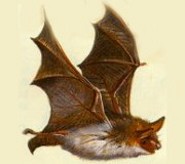
The
Lesser mouse-eared bat (
Myotis blythii) is one of the more common species of
bat in Europe, the Middle East, and even the northwestern regions of India. The Lesser mouse-eared bat, along with its cousin the Greater mouse-eared bat (Myotis myotis), are two of the most numerous bat species in many parts of Europe and Asia and often roost together in larger colonies with other similar species. The Lesser mouse-eared bat is unique in the fact that it feeds almost exclusively in grasslands and meadows with tall vegetation, often hovering or even landing on the ground to capture insects off of the blades of grass.
Myotis blythii is abundant in many areas of southern Europe, while at the same time in areas such as Switzerland they are very rare and were designated as “Strongly Endangered” as recently as 1994. However, the species as a whole is abundant and widespread, with the only real threats being man-made; bat foraging areas are being overrun by urban and agricultural developments, and pollution is always a serious threat. Outside of the human threat, common predators of bats in Europe and Asia are primarily owls, snakes, and a variety of small mammals.
The Lesser mouse-eared bat is a nocturnal species that feeds at night by flying over fields and pastures scouting for insects like crickets and moths. These bats are intelligent and resourceful, with most returning to the same fields night after night; in the event that a field has been cut, burned, or otherwise degraded, the bats will scout the surrounding areas for another suitable foraging ground. One of the most amazing aspects of the Myotis blythii is the hovering maneuvers it utilizes to capture prey; the Lesser mouse-eared bat has been observed hovering in tightening circles until pinpointing the prey, and then hovering right up behind it to pluck it from a blade of grass or a protruding leaf.
Lesser mouse-eared bats are small and have a very delicate appearance, with a soft brown fur often lighter on the underside and sometimes on the head. They typically roost in caves and buildings, church steeples and bell towers being among their favorites, but rarely cause any concern or inconvenience to the human population. The Myotis blythii averages around 16 grams, or 0.04 pounds, but some specimens have weighed in at over 20 grams or more. These bats typically grow to about 65 millimeters in length, or slightly larger than 2 ½ inches, with a wingspan of 350 to 400 millimeters which is equivalent to about one foot. These delicate mammals only have one pup per year, typically between May and July, and are crucial in their role as insect and pest population controllers, as well as helping to pollinate plants and remove pests from certain crops.
Picture of the lesser mouse-eared bat by GeForce3 at en.wikipedia,
licensed under Creative Commons Attribution 3.0 Unported license.
You can help spreading the word about this animal by liking it on facebook
Permanent Link
Thursday 09 December 2010
The Gray Marmot - Not Just a Groundhog
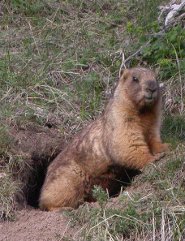
The
gray marmot (Marmota baibacina) is one of a large genus of ground dwelling
rodents, which also includes groundhogs and several other regional species of marmots around the world. The gray marmot is specific to the regions of Xinjiang-Province in China, Kyrgyzstan, Kazakhstan, Mongolia and the Siberian tundra. The gray marmot is also called the Altai marmot, due to its habitation of the Altai and Tien Shan Mountains in Siberia. The gray marmot's habitation area also mingles with the Tarbagan marmot in the Mongolian portion of the Altai Mountain range.
Due to their large populations, the marmot family is not on the endangered species list and is, in fact, listed as one of the animal families showing least concern for extinction. Most of the subgenus of the marmot species are highly interactive and social animals, communication with specific noises much like prairie dogs. Marmots normally dwell in ground burrows in interactive communities and communicate through loud whistles to each other when intruders happen into their area. Marmots, including the gray marmot, gorge themselves on grass, berries, moss, flowers and plant roots prior the hibernating for the winter.
Marmots, especially those in the Mongolian region like the gray marmot, have been a staple of the population's diet. They have been hunted, usually when they are fatted for hibernation, and consume as part of the local fare as "tarvaga". They are also utilized in the creation of "boodog" This is a dish prepared on special occasions by cooking mutton meat with hot stones inside the deboned cavity of a marmot.
Though one of the main predators for marmots is humans, marmots are dangerous and infrequently pose a threat to humans in the form of pneumonic plague. Gray marmots are carriers of this less common form of the plague, which is very virulent. Outbreaks in past years have killed a number of people in Tibet and Mongolia.
Marmots of all types vary in size and coloring; the gray marmot is generally 20 inches in body length with an additional 8 to 9 inches of tail. The width and weight of a marmot will depend on the time of year and how close they are to having their litters, mid-June, and hibernating, late September.
Picture of the gray marmot by Alastair Rae, licensed under
Creative Commons Attribution-Share Alike 3.0 Unported license.
You can help spreading the word about this animal by liking it on facebook
Permanent Link
Tuesday 07 December 2010
Blue Duiker: Bird Food of the Rainforest
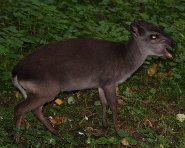
The
Blue Duiker (Cephalophus monticola) is a smallish duiker residing mostly in Central and Southern Africa. Standing up to 35 centimeters with a weight of up to 4 kilograms, the blue duiker is an omnivore that feeds on the floor of the forest. The animal's tendency to inhabit rain forests makes it prey for the
Crowned Eagle, becoming an easy target as it scours the forest floor for fruit, leaves, eggs and bugs. The solitary, nocturnal habits of the blue duiker are both an asset and a disadvantage in this regard, lacking the protection of a herd but doing most of its feeding in the low visibility of night.
Blue Duikers are distinguished from other duikers by the slight blue shine of their coat. Although not overtly blue in appearance, the tinge is enough to warrant distinguishing from others of the same family. Conical horns are present on the forehead of the male animal, though females won't always bare them. Resembling a small deer, duikers are more easily found than many other small mammals. Duikers are common throughout Africa, and the Blue Duiker is no exception. In certain areas of Gabon, the population density of the Blue Duiker can reach upwards of 80 animals in any square kilometer. Maintaining territorial bounds in such a dense population can be tense, and the Blue Duiker is particularly sensitive to its domain. Chasing off intruders and even their own family, Blue Duikers will use dung and glandular excretions to make their mark and stake their claim. Young are only permitted to stay with the parents until the age of roughly 18 months, at which point they will be forced out on their own.
The canopy of the rainforest that provides so many creatures with shelter is the main source of protection and sustenance for the Blue Duiker population. Although nowhere near threatened or endangered, deforestation could eventually have a negative impact on the Blue Duiker population. The animal’s refusal to associate with others of the breed - aside from the period of parenthood and traveling as mating pairs - will help to prolong their survival by avoiding the massive population losses common with herds.
Picture of the blue duiker by Hartmut Inerle, Zoo Krefeld, licensed under
Creative Commons Attribution-Share Alike 3.0 Unported license.
You can help spreading the word about this animal by liking it on facebook
Permanent Link
Monday 06 December 2010
Guereza
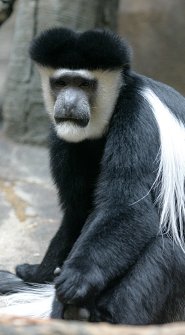
The
Guereza (
Colobus guereza) is a beautiful primate that is known by many names - Mantled Guereza, Black and white Colobus, Magistrate colobus, or Abynisian Black and white Colobus. It has long hair - black and white - with a white patch of long hair cascading to the sides, from the back, usually a U shape and has a white face and the top of its head is black, looking like it is wearing a fur hat. The long hairy tail has white hair that spreads like a horse's mane; it also has black in it. This remarkable animal would resemble a giant skunk with a
primate's face.
The Guereza can be found in Africa, especially in the regions of the east and west central. This mammal grows to be 18-28 inches (or up to 61.5 cm) and the tail is about as long as the body or longer. The tail is longer than the entire body. It can weight from twelve to thirty pounds (or 9.3 -13.5 kilograms). The Colobus guereza likes to sit on top of branches and to jump from tree to tree, thanks to its posterior muscular short legs. It also has very small thumbs - almost absent. The babies are all white when they are born (every twenty months) and obtain their particular fur markings later. Babies mature to adult in four to six years. The gestation lasts five months. This animal can be found in the forests that are closer to bodies of water. It likes to eat fruits, flowers, leaves, seeds, and other vegetation types. One important fact is that its large stomach is capable of processing the type of food it eats - a stomach with multiple chambers. The Guereza is diurnal, and likes to go high on the trees. However, it can also live in grassy areas or lowlands. This monkey spends half of the day resting, and the rest feeding, sitting, or galloping/leaping. In captivity, they can live up to 23 years.
This species has its own territory and groups of six to nine live in about forty acres (160,000 m2) of land; they warn other groups of their presence by using sounds and making noises. However, they can share part of that territory with other groups, and they live among other types of primates. They socialize with other species. It has two major predators - the Crowned hawk eagle and the Chimpanzee. It is not considered a threatened species.
Picture of the Guereza by Cburnett, licensed under
GFDL
You can help spreading the word about this animal by liking it on facebook
Permanent Link
Thursday 02 December 2010
Angolan Colobus - the Cruella Deville Look-a-like
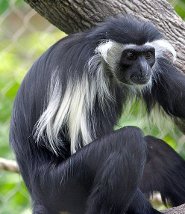
The
Angolan colobus (
Colobus angolensis) belongs to a group of five species of Black-and-white colobus in the genus Colubus. All five have similar unique characteristics, including a very long tail and long, soft hair. They are without thumbs, unlike any other species of monkey. In fact, the word colobus means "mutilated one". They are mostly black, with long white fur on their shoulders, tails, eyebrows, cheeks and neck. This makes them truly look similar to Cruella Deville.
These beautiful monkeys are medium sized, with the males being slightly larger than the females. At maturity they range from 13 to 26 pounds (6 to 12 kg) and males can grow up to 2 ½ feet long (76 cm). They are native to many African countries, including Nigeria, Zaire, Ethiopia and Kenya.
The Angolan colobus monkey can be found living in a wide range of habitats, from swampy areas and savannas, to tropical forests and high altitude areas. They prefer to stay high in the treetops, but will come to the ground to feed on vegetation and to drink. Like most monkeys, they eat primarily leaves, but also feed on small insects, tree bark, fruits and flowers. Among their favorite foods are the leaves of the Hackberry tree.
Colobus monkeys are territorial, and tend to live in small groups, though very large troops have been seen occasionally. There is often just one male with many females, and he actively protects them by roaring and jumping to scare off possible predators. Since they stay in the canopy most of the time, they avoid many of their natural predators, though they are preyed upon by animals that can climb or fly, such as
leopards, large eagles, but also
humans, sadly.
Angolan colobus babies are born after a gestation period that ranges from 147 to 178 days. Mothers usually have just one baby, though twins do occur. The babies are all white at birth, and become bi-colored when they are about three months of age. They are not weaned until they are 15 months old.
These monkeys have a long life span, living up to 20 years in the wild. They have been known to live as long as 30 years when raised in captivity, however. They are quite abundant throughout Africa, but are threatened by the destruction of their natural habitats. In addition, they are hunted for their meat and hides, causing their population to decrease rapidly in some areas.
Picture of the Angolan colubus by
Ryan E. Poplin, licensed under
Creative Commons Attribution-Share Alike 2.0 Generic license.
You can help spreading the word about this animal by liking it on facebook
Permanent Link
 The Patagonian Mara (Dolichotis patagonum) lives in south and central Argentina mainly in areas of scrub desert or coarse grassland. It is a rodent resembling a short eared hare also called the Patagonian hare or Patagonian cavy but is actually a close relative of the guinea pig. It is one of the few rodents that mate for life, and its social structure is based on this. Pairs will travel everywhere together with the female in the lead and the male watching out for danger.
The Patagonian Mara (Dolichotis patagonum) lives in south and central Argentina mainly in areas of scrub desert or coarse grassland. It is a rodent resembling a short eared hare also called the Patagonian hare or Patagonian cavy but is actually a close relative of the guinea pig. It is one of the few rodents that mate for life, and its social structure is based on this. Pairs will travel everywhere together with the female in the lead and the male watching out for danger.
 The
The  The
The  The
The  The
The  The
The  The
The  The
The  The
The  The
The